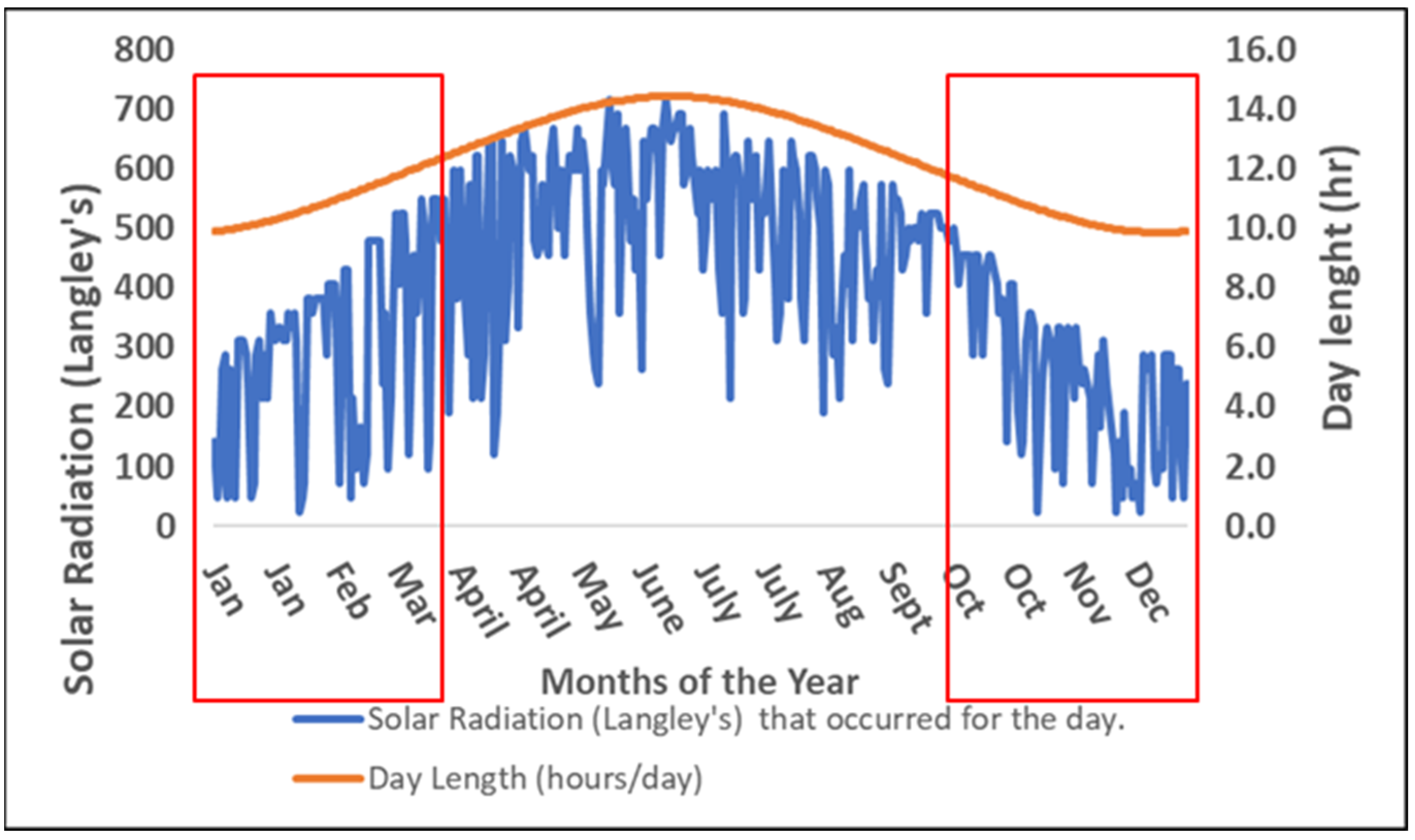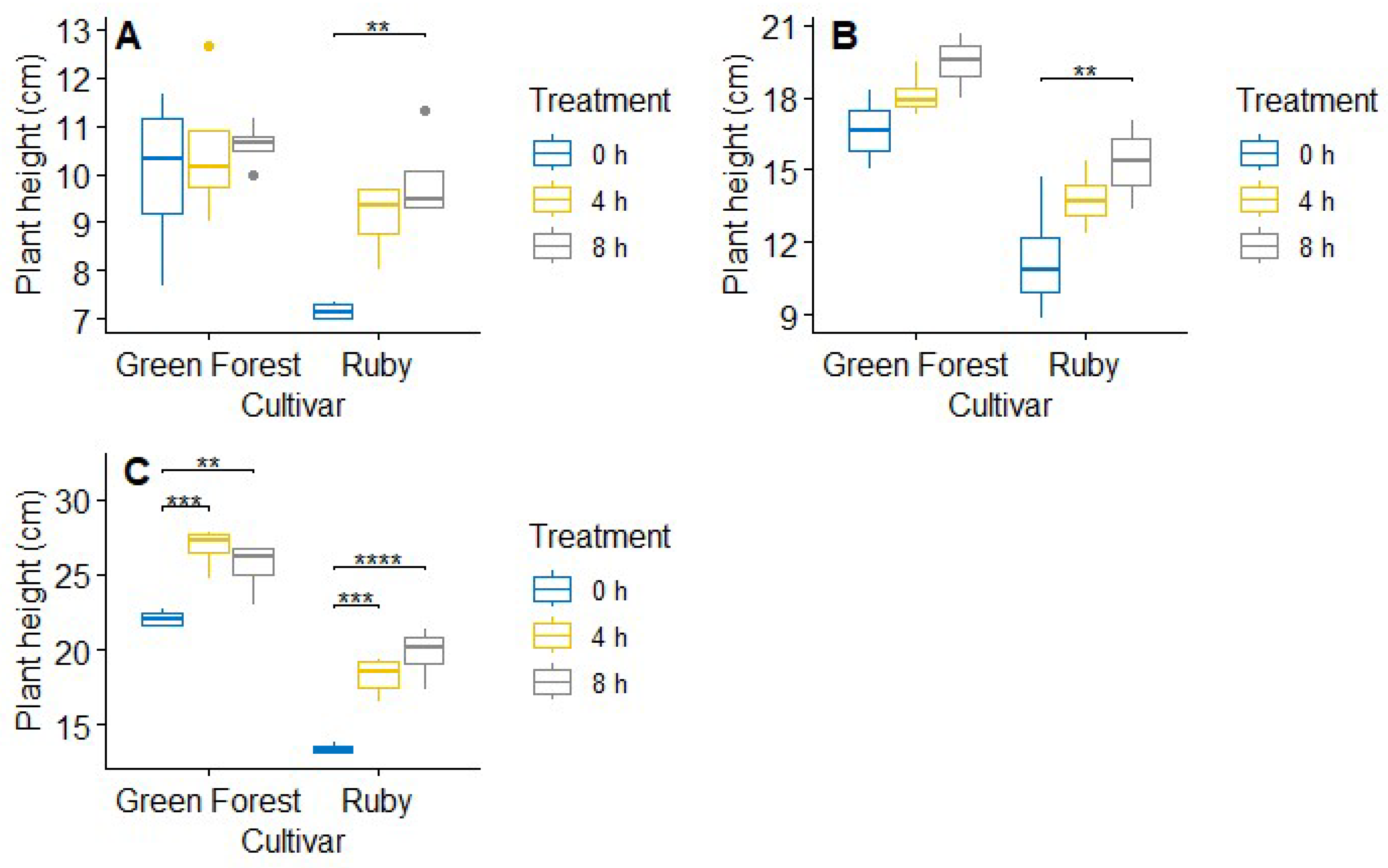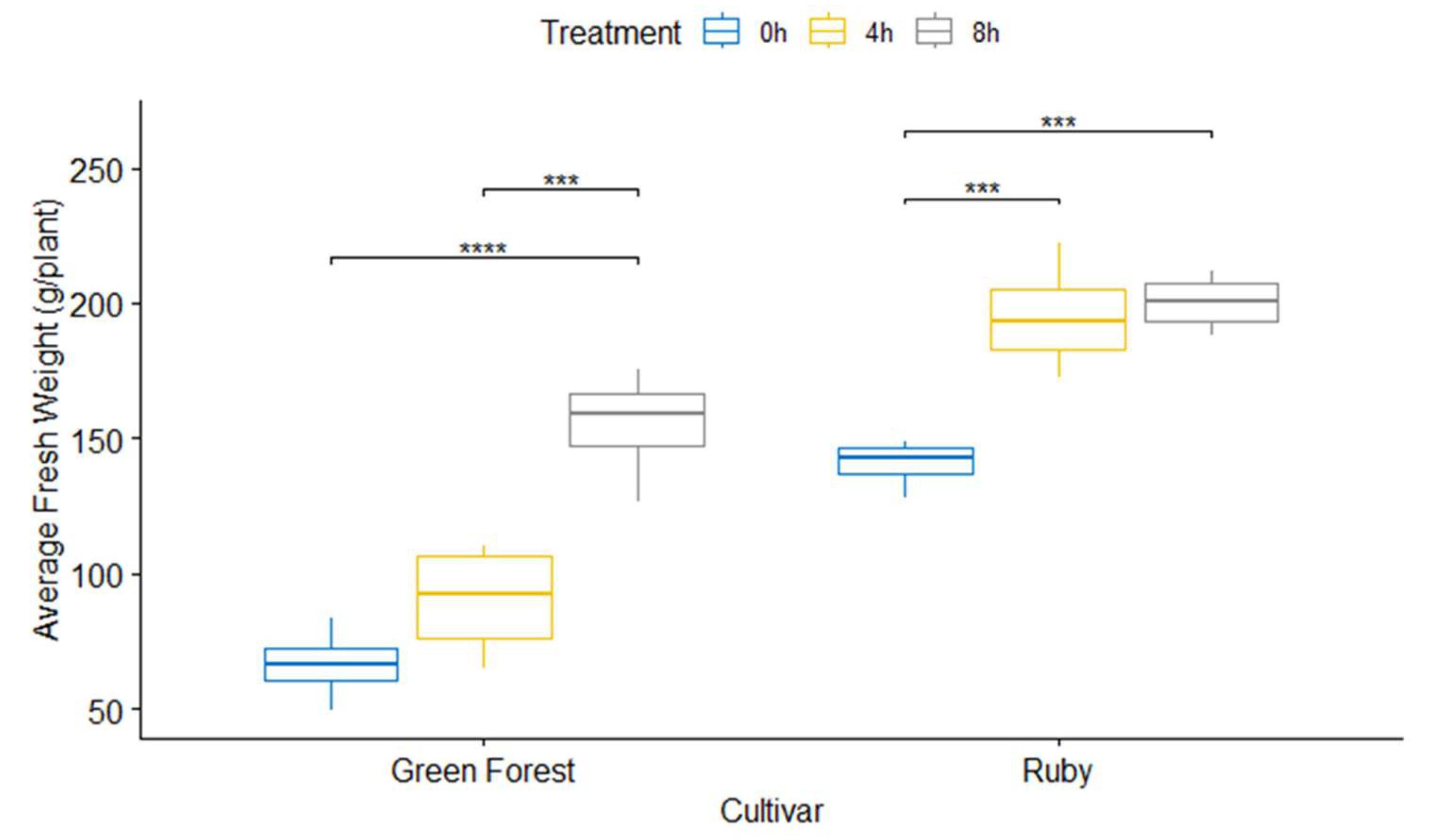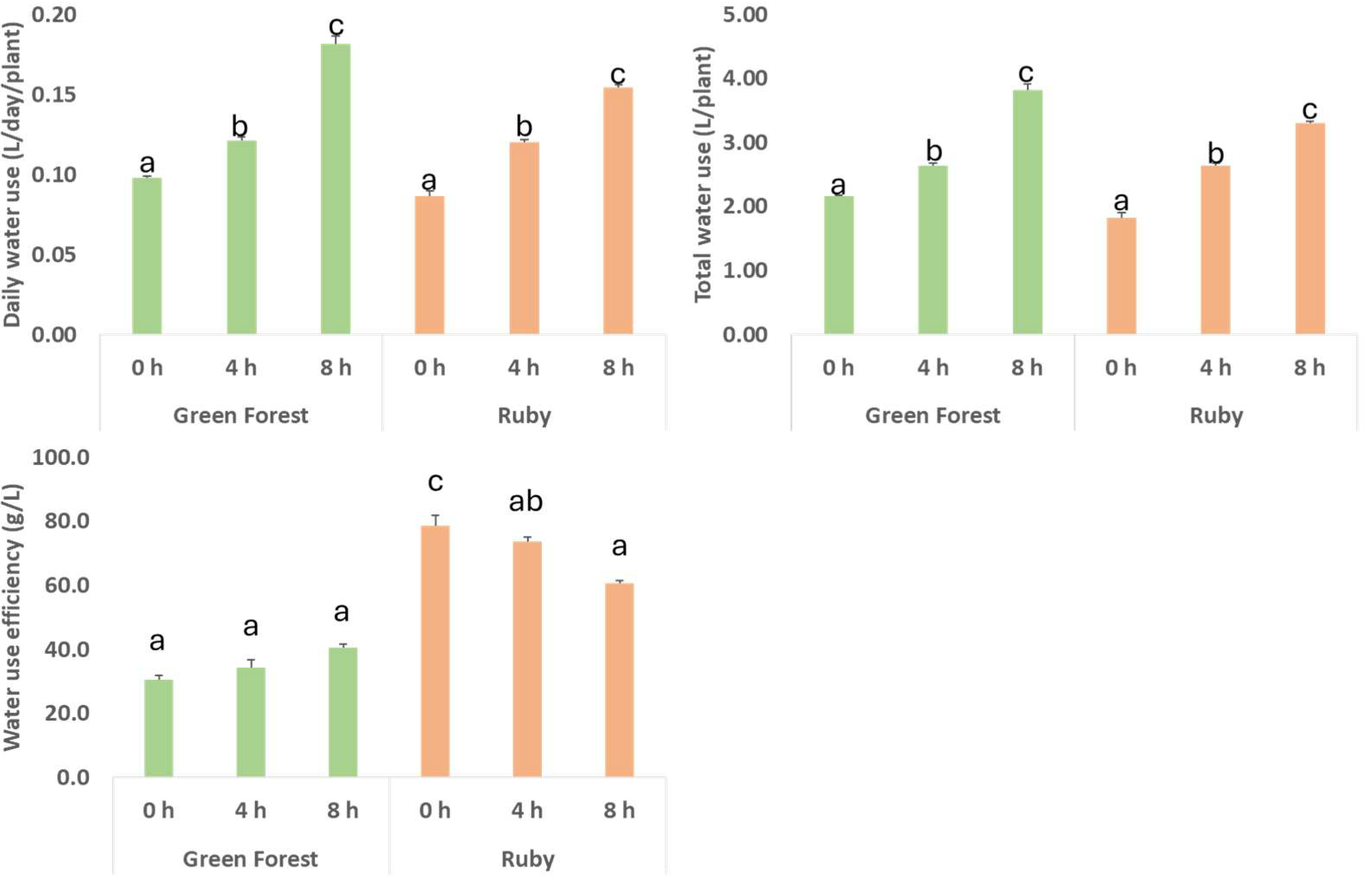Effects of Light Supplementation on Lettuce Growth, Yield, and Water Use During Winter Season in North Mississippi
Abstract
1. Introduction
2. Materials and Methods
2.1. Seedling Preparation and Growing Environment
2.2. Treatment Specification and Nutrient Management
2.3. Data Collection
2.4. Data Analysis
3. Results and Discussions
3.1. Effects of Light Supplementation on Lettuce Growth: Head Diameter
3.2. Effects of Light Supplementation on Lettuce Growth: Plant Height
3.3. Effects of Light Supplementation on Lettuce Growth: Leaf Number
3.4. Effects of Light Supplementation on Lettuce Yield
3.5. Effects of Light Supplementation on Water Use and Water Use Efficiency
4. Conclusions
Author Contributions
Funding
Institutional Review Board Statement
Informed Consent Statement
Data Availability Statement
Acknowledgments
Conflicts of Interest
References
- FAOSTAT. Available online: https://www.fao.org/faostat/en/#data/QCL (accessed on 1 April 2025).
- USDA-ERS. U.S. Lettuce Production Shifts Regionally by Season|Economic Research Service. Available online: https://www.ers.usda.gov/data-products/charts-of-note/chart-detail?chartId=106516 (accessed on 26 May 2025).
- USDA/NASS. Available online: https://www.nass.usda.gov/Publications/AgCensus/2022/index.php (accessed on 3 April 2025).
- Fujiwara, M.; Kubota, C.; Kozai, T.; Sakami, K. Air temperature effect on leaf development in vegetative propagation of sweetpotato single node cutting under artificial lighting. Sci. Hortic. 2004, 99, 249–256. [Google Scholar] [CrossRef]
- Hatfield, J.L.; Prueger, J.H. Temperature extremes: Effect on plant growth and development. Weather. Clim. Extrem. 2015, 10, 4–10. [Google Scholar] [CrossRef]
- Sublett, W.L.; Barickman, T.C.; Sams, C.E. The Effect of Environment and Nutrients on Hydroponic Lettuce Yield, Quality, and Phytonutrients. Horticulturae 2018, 4, 48. [Google Scholar] [CrossRef]
- Ahmed, H.A.; Tong, Y.-X.; Yang, Q.-C. Optimal control of environmental conditions affecting lettuce plant growth in a controlled environment with artificial lighting: A review. S. Afr. J. Bot. 2020, 130, 75–89. [Google Scholar] [CrossRef]
- Zhou, J.; Li, P.; Wang, J. Effects of Light Intensity and Temperature on the Photosynthesis Characteristics and Yield of Lettuce. Horticulturae 2022, 8, 178. [Google Scholar] [CrossRef]
- Jenni, S.; Yan, W. Genotype by environment interactions of heat stress disorder resistance in crisphead lettuce. Plant Breed. 2009, 128, 374–380. [Google Scholar] [CrossRef]
- Lafta, A.; Sandoya, G.; Mou, B. Genetic Variation and Genotype by Environment Interaction for Heat Tolerance in Crisphead Lettuce. HortScience 2021, 56, 126–135. [Google Scholar] [CrossRef]
- Pereira, M.C.; Souza, N.O.S.; Nascimento, W.M.; da Silva, G.O.; da Silva, C.R.; Suinaga, F.A. Stability Evaluation for Heat Tolerance in Lettuce: Implications and Recommendations. Plants 2024, 13, 1546. [Google Scholar] [CrossRef]
- Hiroki, R.; Shimizua, H.; Ito, A.; Nakashima, H.; Miyasaka, J.; Ohdoi, K. Identifying the optimum light cycle for lettuce growth in a plant factory. Acta Hortic. 2014, 1037, 863–868. [Google Scholar] [CrossRef]
- Razzak, M.A.; Asaduzzaman, M.; Tanaka, H.; Asao, T. Effects of supplementing green light to red and blue light on the growth and yield of lettuce in plant factories. Sci. Hortic. 2022, 305, 111429. [Google Scholar] [CrossRef]
- Boros, I.F.; Székely, G.; Balázs, L.; Csambalik, L.; Sipos, L. Effects of LED lighting environments on lettuce (Lactuca sativa L.) in PFAL systems—A review. Sci. Hortic. 2023, 321, 112351. [Google Scholar] [CrossRef]
- Ju, J.; Zhang, S.; Hu, Y.; Zhang, M.; He, R.; Li, Y.; Liu, X.; Liu, H. Effects of Supplemental Red and Far-Red Light at Different Growth Stages on the Growth and Nutritional Properties of Lettuce. Agronomy 2024, 14, 55. [Google Scholar] [CrossRef]
- Landi, M.; Zivcak, M.; Sytar, O.; Brestic, M.; Allakhverdiev, S.I. Plasticity of photosynthetic processes and the accumulation of secondary metabolites in plants in response to monochromatic light environments: A review. Biochim. Biophys. Acta Bioenerg. 2020, 1861, 148131. [Google Scholar] [CrossRef]
- Ptushenko, O.S.; Ptushenko, V.V.; Solovchenko, A.E. Spectrum of Light as a Determinant of Plant Functioning: A Historical Perspective. Life 2020, 10, 25. [Google Scholar] [CrossRef]
- Ruban, A.V. Evolution under the sun: Optimizing light harvesting in photosynthesis. J. Exp. Bot. 2015, 66, 7–23. [Google Scholar] [CrossRef]
- Iqbal, Z.; Munir, M.; Sattar, M.N. Morphological, Biochemical, and Physiological Response of Butterhead Lettuce to Photo-Thermal Environments. Horticulturae 2022, 8, 515. [Google Scholar] [CrossRef]
- Shen, Y.Z.; Guo, S.S.; Ai, W.D.; Tang, Y.K. Effects of illuminants and illumination time on lettuce growth, yield and nutritional quality in a controlled environment. Life Sci. Space Res. 2014, 2, 38–42. [Google Scholar] [CrossRef]
- Smirnov, A.A.; Semenova, N.A.; Dorokhov, A.S.; Proshkin, Y.A.; Godyaeva, M.M.; Vodeneev, V.; Sukhov, V.; Panchenko, V.; Chilingaryan, N.O. Influence of Pulsed, Scanning and Constant (16- and 24-h) Modes of LED Irradiation on the Physiological, Biochemical and Morphometric Parameters of Lettuce Plants (Lactuca sativa L.) while Cultivated in Vertical Farms. Agriculture 2022, 12, 1988. [Google Scholar] [CrossRef]
- Yudina, L.; Sukhova, E.; Gromova, E.; Mudrilov, M.; Zolin, Y.; Popova, A.; Nerush, V.; Pecherina, A.; Grishin, A.A.; Dorokhov, A.A.; et al. Effect of Duration of LED Lighting on Growth, Photosynthesis and Respiration in Lettuce. Plants 2023, 12, 442. [Google Scholar] [CrossRef]
- Didaran, F.; Kordrostami, M.; Ghasemi-Soloklui, A.A.; Pashkovskiy, P.; Kreslavski, V.; Kuznetsov, V.; Allakhverdiev, S.I. The mechanisms of photoinhibition and repair in plants under high light conditions and interplay with abiotic stressors. J. Photochem. Photobiol. B 2024, 259, 113004. [Google Scholar] [CrossRef]
- Sena, S.; Kumari, S.; Kumar, V.; Husen, A. Light emitting diode (LED) lights for the improvement of plant performance and production: A comprehensive review. Curr. Res. Biotechnol. 2024, 7, 100184. [Google Scholar] [CrossRef]
- Gavhane, K.P.; Hasan, M.; Singh, D.K.; Kumar, S.N.; Sahoo, R.N.; Alam, W. Determination of optimal daily light integral (DLI) for indoor cultivation of iceberg lettuce in an indigenous vertical hydroponic system. Sci. Rep. 2023, 13, 10923. [Google Scholar] [CrossRef]
- Baumbauer, D.A.; Schmidt, C.B.; Burgess, M.H. Leaf Lettuce Yield Is More Sensitive to Low Daily Light Integral than Kale and Spinach. HortScience 2019, 54, 2159–2162. [Google Scholar] [CrossRef]
- Yan, Z.; He, D.; Niu, G.; Zhai, H. Evaluation of growth and quality of hydroponic lettuce at harvest as affected by the light intensity, photoperiod and light quality at seedling stage. Sci. Hortic. 2019, 248, 138–144. [Google Scholar] [CrossRef]
- Zhang, X.; He, D.; Niu, G.; Yan, Z.; Song, J. Effects of environment lighting on the growth, photosynthesis, and quality of hydroponic lettuce in a plant factory. Int. J. Agric. Biol. Eng. 2018, 11, 33–40. [Google Scholar] [CrossRef]
- Matysiak, B.; Ropelewska, E.; Wrzodak, A.; Kowalski, A.; Kaniszewski, S. Yield and Quality of Romaine Lettuce at Different Daily Light Integral in an Indoor Controlled Environment. Agronomy 2022, 12, 1026. [Google Scholar] [CrossRef]
- Dannehl, D.; Schwend, T.; Veit, D.; Schmidt, U. LED versus HPS Lighting: Effects on Water and Energy Consumption and Yield Quality in Lettuce Greenhouse Production. Sustainability 2021, 13, 8651. [Google Scholar] [CrossRef]







| Sampling Date | Effect | DFn | DFd | F | p | p < 0.05 |
|---|---|---|---|---|---|---|
| 1 Week After Treatment | Treatment | 2 | 6 | 12.731 | 0.007 | * |
| Cultivar | 1 | 3 | 0.100 | 0.773 | ||
| Treatment–Cultivar | 2 | 6 | 3.546 | 0.096 | ||
| 2 Weeks After Treatment | Treatment | 2 | 6 | 1.870 | 0.234 | |
| Cultivar | 1 | 3 | 0.170 | 0.708 | ||
| Treatment–Cultivar | 2 | 6 | 2.596 | 0.154 | ||
| 3 Weeks After Treatment | Treatment | 2 | 6 | 35.110 | 0.0004 | * |
| Cultivar | 1 | 3 | 155.71 | 0.001 | * | |
| Treatment–Cultivar | 2 | 6 | 0.41 | 0.568 |
| Sampling Date | Effect | DFn | DFd | F | p | p < 0.05 |
|---|---|---|---|---|---|---|
| 1 Week After Treatment | Treatment | 2 | 6 | 7.951 | 0.021 | * |
| Cultivar | 1 | 3 | 24.701 | 0.016 | * | |
| Treatment–Cultivar | 2 | 6 | 1.965 | 0.221 | ||
| 2 Weeks After Treatment | Treatment | 2 | 6 | 5.475 | 0.044 | * |
| Cultivar | 1 | 3 | 291.093 | 0.000439 | * | |
| Treatment–Cultivar | 2 | 6 | 0.578 | 0.589 | ||
| 3 Weeks After Treatment | Treatment | 2 | 6 | 63.909 | 9.01 × 10−5 | * |
| Cultivar | 1 | 3 | 1113.29 | 5.92 × 10−5 | * | |
| Treatment–Cultivar | 2 | 6 | 1.851 | 0.236 |
| Sampling Date | Effect | DFn | DFd | F | p | p < 0.05 |
|---|---|---|---|---|---|---|
| 1 Week After Treatment | Treatment | 2 | 6 | 5.93 | 0.038 | * |
| Cultivar | 1 | 3 | 7.76 | 0.069 | ||
| Treatment–Cultivar | 2 | 6 | 0.99 | 0.424 | ||
| 2 Weeks After Treatment | Treatment | 2 | 6 | 6.55 | 0.031 | * |
| Cultivar | 1 | 3 | 206.54 | 0.00073 | * | |
| Treatment–Cultivar | 2 | 6 | 0.27 | 0.773 | ||
| 3 Weeks After Treatment | Treatment | 2 | 6 | 6.52 | 0.031 | * |
| Cultivar | 1 | 3 | 7.38 | 0.073 | ||
| Treatment–Cultivar | 2 | 6 | 0.19 | 0.828 |
| Effect | DFn | DFd | F | p | p < 0.05 |
|---|---|---|---|---|---|
| Treatment | 2 | 9 | 36.871 | 4.62 × 10−5 | * |
| Cultivar | 1 | 9 | 122.00 | 1.56 × 10−6 | * |
| Treatment–Cultivar | 2 | 9 | 6.472 | 1.80 × 10−2 | * |
Disclaimer/Publisher’s Note: The statements, opinions and data contained in all publications are solely those of the individual author(s) and contributor(s) and not of MDPI and/or the editor(s). MDPI and/or the editor(s) disclaim responsibility for any injury to people or property resulting from any ideas, methods, instructions or products referred to in the content. |
© 2025 by the authors. Licensee MDPI, Basel, Switzerland. This article is an open access article distributed under the terms and conditions of the Creative Commons Attribution (CC BY) license (https://creativecommons.org/licenses/by/4.0/).
Share and Cite
Ayankojo, I.T.; Horgan, T.; Wilson, J. Effects of Light Supplementation on Lettuce Growth, Yield, and Water Use During Winter Season in North Mississippi. Agronomy 2025, 15, 1635. https://doi.org/10.3390/agronomy15071635
Ayankojo IT, Horgan T, Wilson J. Effects of Light Supplementation on Lettuce Growth, Yield, and Water Use During Winter Season in North Mississippi. Agronomy. 2025; 15(7):1635. https://doi.org/10.3390/agronomy15071635
Chicago/Turabian StyleAyankojo, Ibukun T., Thomas Horgan, and Jeff Wilson. 2025. "Effects of Light Supplementation on Lettuce Growth, Yield, and Water Use During Winter Season in North Mississippi" Agronomy 15, no. 7: 1635. https://doi.org/10.3390/agronomy15071635
APA StyleAyankojo, I. T., Horgan, T., & Wilson, J. (2025). Effects of Light Supplementation on Lettuce Growth, Yield, and Water Use During Winter Season in North Mississippi. Agronomy, 15(7), 1635. https://doi.org/10.3390/agronomy15071635






